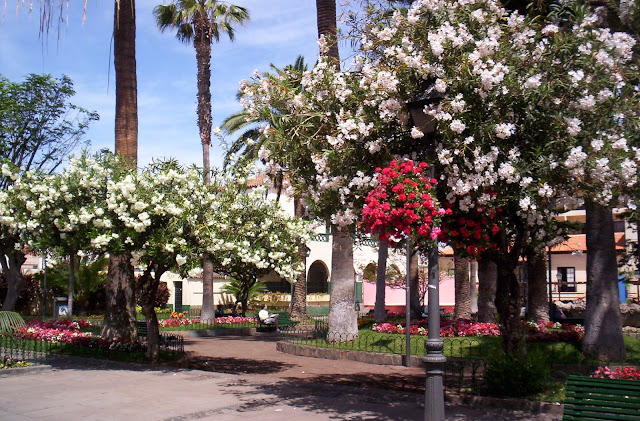 |
| Rosquetes canarios (Canarian donuts) |
Fried donuts filled with a boozy, nutty, syrupy mixture, what's not to like? Some effort, but should be well worth it. Those of 'of a certain age' may be familiar with the curious old measurements that appeared in this ancient Canarian recipe.
Ingredients:
1 egg and 4 egg yolks
½ pound (250g) of flour
½ pound (250g) of lard
2 teaspoons of yeast
juice of 1.5 lemons
a pinch of salt
butter for spreading
2 ounces (57.4g) peeled almonds
½ pound (250g) of sugar
a glass of anise liqueur
ground cinnamon
anise/aniseed
Sherry
Method:
Beat a whole egg. Next, mix ½ pound of flour and ½ pound of lard and two teaspoons of yeast. When they are well mixed, add the beaten egg, which has previously been mixed with the water that is necessary [going to have to guess this one], the juice of 1 lemon and a pinch of salt. After kneading everything very well, roll out the dough on a floured surface. When well extended, it needs to be folded into four. It is first spread well with butter. This must be done three times, letting butter rest from one layer to another, for about ten minutes.
Fry two ounces of peeled almonds then grind them. Then a syrup is made, heating half a pound of sugar with half a quart of water and stirring well (remove from the heat when the syrup coats the back of the spoon, hanging on it as if it were a strand). To this syrup are added the ground almonds, the juice of half a lemon, a glass of anise liqueur, a pinch of ground cinnamon, a pinch of anise, half a portion of Sherry wine and four egg yolks. When all the ingredients have been mixed well, heat this paste until it is well cooked. It is better to wait a day (leave in a cool place) before filling this paste into the donuts.
Roll out the previously prepared dough with a rolling pin. Then cut into pieces four fingers wide, put a little of the filling in the centre of the dough and then roll it, like a cigar, forming the donut. The donuts are then fried in very hot oil.
The old measurements that were in the original recipe:
- Libra (Pound): Old weight, variable according to the provinces, in the Canary Islands it can be compared to 500 grams. Therefore, in this recipe 250 grams are mixed. flour and 250 grs. lard. The syrup is also made with 250 grams. of sugar.
- Onza (Ounce): Weight that consists of 16 adarmes and is equivalent to 287 decigrams. Therefore, in this recipe, the filling of the donuts is made with 57.4 grs. peeled almonds.
- Cuartillo (Quart): Measurement of liquids, a quarter of a gallon, equivalent to 504 milliliters. Therefore, in this recipe the syrup is made with ¼ liter of water.
- Polvo (Powder): Powder is understood as that which is only taken with the fingertips of the thumb and index finger [.i.e. a pinch].
The video below shows a more usual recipe for Rosquetes canarios (Canarian donuts), in which the unfilled donuts are fried and then bathed in sugar syrup.
Recetas de cocina fácil - Rosquetes canarios





 After more than 20 years, posts here will now only be occasional (
After more than 20 years, posts here will now only be occasional (







